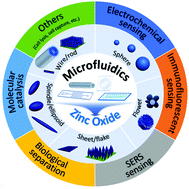Microfluidics for ZnO micro-/nanomaterials development: rational design, controllable synthesis, and on-chip bioapplications
Abstract
Zinc oxide (ZnO) materials hold great promise in diverse applications due to their attractive physicochemical features. Recent years, especially the last decade, have witnessed considerable progress toward rational design and bioapplications of multiscale ZnO materials through microfluidic techniques. Design of a microfluidic device that allows for precise control over reaction conditions could not only yield ZnO particles with a fast production rate and high quality, but also permit downstream applications with desirable and superior performance. This review summarizes microfluidic approaches for the synthesis and applications of ZnO micro-/nanomaterials. In particular, we discuss the recent achievement of using microfluidic reactors in the controllable synthesis of ZnO structures (wire, rod, sphere, flower, sheet, flake, spindle, and ellipsoid), and highlight the unprecedented opportunities for applying them in biosensing, biological separation, and molecular catalysis applications through microfluidic chips. Finally, major challenges and potential opportunities are explored to guide future studies in this area.

- This article is part of the themed collection: Editor’s Choice: Microfluidics


 Please wait while we load your content...
Please wait while we load your content...